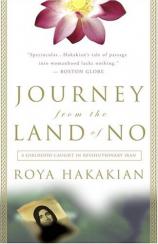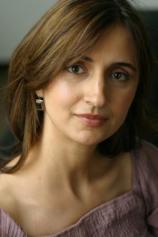Reading Group Guide
Discussion Questions
Journey from the Land of No: A Girlhood Caught in Revolutionary Iran

1. Roya refers to her brother Albert's departure for America as "the first mystery of my life." How does she go about sleuthing out his reasons for leaving? What political realities does she glean from the coded images in Tofigh magazine? What is the significance of the image of the black fish, "lynched, hanging lifeless in the middle of the page?" Why does she fail to question her family about these strange images?
2. Roya views her uncle Ardi as a stunning success for his ability to pass as a Muslim: "Even Jews mistook him for a Muslim and behaved as they did in the company of one. They offered him the best seat in the house and waited cheerfully on him... He had made a safe passage to the other side." Why is the family awed by and envious of this phenomenon, yet horrified when Ardi wants to marry a Muslim woman? What does Roya learn about her own identity as a Middle Eastern Jewish female from this episode? She writes, "What Uncle Ardi had really shed was fear, the fear of claiming his share of the good life like any other middle-class citizen." Why does the Ayatollah's return in 1979 reverse Ardi's luck?
3. What do the ads in Today's Woman reveal about the status of women in Iran in the1960s and 1970s? Neela's mother wore a black veil, whereas her daughters dressed in modern clothes and did not cover their hair. What does this say about the attitude of Iranians toward women in those years? How does that attitude change after the revolution in the 1980s?
4. The Seamus Heaney poem quoted at the beginning of the memoir concludes with: "Now, to pry into roots, to finger slime/To stare, big-eyed Narcissus, into some spring/Is beneath all adult dignity. I rhyme/To see myself, to set the darkness echoing." Discuss Roya's use of writing as a replacement for more childlike coping mechanisms. What are the circumstances during which Roya discovers writing as a liberating and grounding act?
5. Roya describes a subtle but pronounced shift in mood and physical comfort from being among all Jews --- "effortless, like being in my pajamas"--to being around a mixed group of Jews and Muslims--"like being in my party dress... the fabric itched... the zipper pinched." Yet she enjoys the slight discomfort: "I liked how it changed me... I liked how all of us reshuffled to put on our dress as a family." Is this a childish conceit? If not, discuss why Roya is energized by this tension. Is her family similarly energized?
6. When Jahan questions Farah's virtue the morning after their wedding, throwing the family into turmoil, Roya discovers that, despite all their bluster and swagger about keeping women from harm, men are useless. "All of them stood by and watched Farah be forsaken, realizing this should have saddened or disillusioned me. But, instead, it filled me with glee." Why? Why does this incident inspire Roya to rush home and read, a pursuit she calls "my corrective device?"
7. Why is Roya thrown into a panic when her classmates at the Jewish girls' school nominate her as their class representative? Why does she insist, "Genius snapped all good things in half... Clown was the praise I longed to hear?"
8. Like many Iranians enraptured by the revolution, Roya is callous toward the early executions of the shah's ministers by the Ayatollah's administration. "I smiled too. I, too, believed those dead to be lesser people, if they were people at all." What changes her attitude?
9. Why does Roya refer to Z's home as "that other school," and a place where "I watched my childishness swirl down the drain." What private rituals are enacted in this basement by Bibi, Roya and Z, and Great-Uncle? What impact will they have on Roya's future?
10. Mrs. Arman uses a strategy of touch in her attempt to reach and rehumanize Roya and her classmates under their government-mandated veils. "She would... stand behind the next student, tug at the next scarf, turn the next collar over, lay her book on a head or her hands on one of our shoulders... she undid what the uniforms were meant to do: drive us out of sight." Where else do we see physical contact used as an antidote to the depersonalizing effects of the Ayatollah's regime? What prompts Roya to comment, "How much more tolerable everything would be in Iran if only I could live in it blind?"
11. As Tehran's political climate grows increasingly threatening to non-Muslims, and the family's avenues of escape narrow, Roya observes her father's harnessing of poetry as both solace and weapon. "He locked himself in a room for days to forge his own brand of remedy: compose a poem for the passport officials!... Thrilled by his creation, he smiled the smile of a great schemer on the verge of pulling a most vicious trick on his unknowing adversaries." Discuss the role of poetry in Hakakian family mythology, and in the fabric of prerevolutionary, everyday Iran. Was there a comparable tradition of poetics anywhere in the West during this same time period? Where in the text of the memoir do you find lyricism and/or rhythm that hint at the Iranian appetite for poetry?
12. Of starting over in the United States, Roya writes,"In the new country, you must begin anew. To make yourself do so, you invent a metaphor. Not a beautiful metaphor, but a practical one to propel you. You imagine you are a secondhand car whose odometer has been reset to zero by exile...." What feature of her friendship with David Unger of the New York Times persuades Roya to step out of this exile and examine her memories? Why is her choice between Persian and English so vital to the writing of this memoir?
13. What is the truth behind the disappearance of Samad Behrangi, author of The Little Black Fish? Why does it smack of betrayal to thousands of young revolutionaries? The book begins with the story of Behrangi, the mystery of a death, and notions of blood and sacrifice run through the whole story. What is the significance of each of these notions in Roya's life? What do they reveal about the Iranian culture?
Journey from the Land of No: A Girlhood Caught in Revolutionary Iran
- Publication Date: June 28, 2005
- Paperback: 272 pages
- Publisher: Three Rivers Press
- ISBN-10: 0609810308
- ISBN-13: 9780609810309








